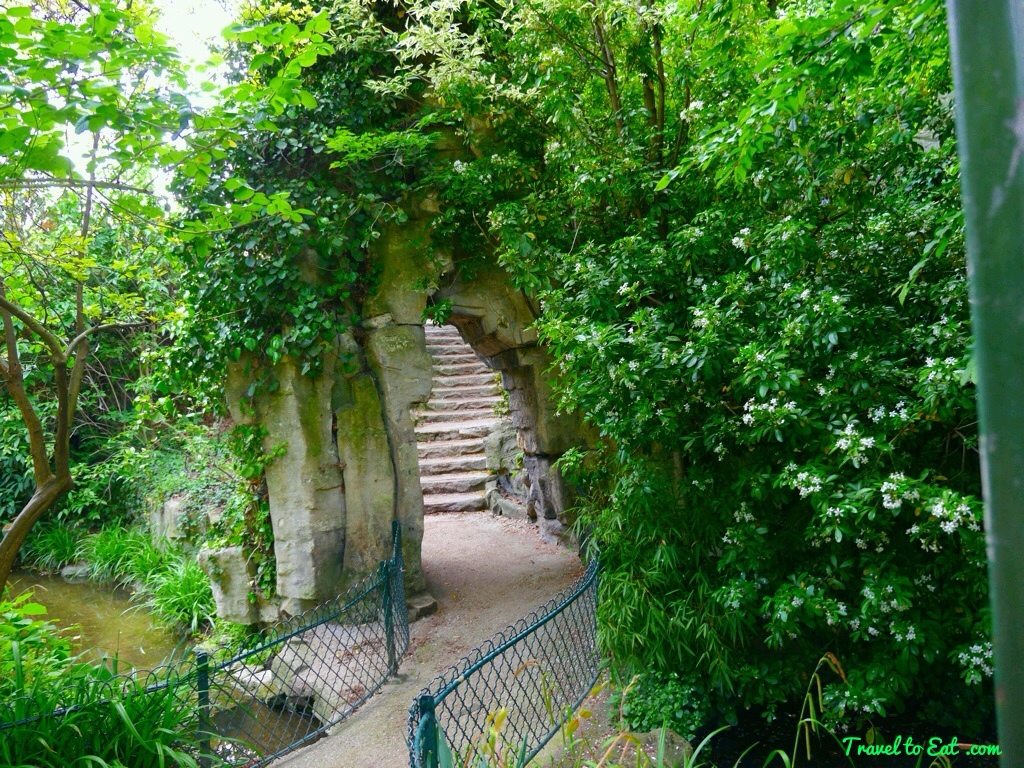
Everyone who visits Paris wants to find a secret spot and/or romantic interlude known only to them. The small Jardin de la Nouvelle France on the far side the Palais de la Découverte, at the corner of avenue Franklin D. Roosevelt and Cours la Reine, easily meets both requirements assuming you bring a lover along. For a small 1.7 acre park in an out of the way location this particular Paris park draws a lot of attention. “New York Times” writer Elaine Sciolino describes it as a “tiny stage set.” Richard West writes, “A small waterfall, a weeping beech tree, lilacs and maples, a wooden footbridge-the perfect edenic, quiet spot to contemplate whether the poet Baudelaire really wore a green wig.” Susan Cahill calls it “The enchanting Garden Valley Switzerland, invisible from the street, accessible only if you know how to find the path.”

Over the years it has gone by several names, the Garden of the Swiss Valley, the Garden of Anne Savage (1896-1971) and finally the Jardin de la Nouvelle France. Part of the Champs-Élysées’ gardens, this “Swiss Valley” was built from scratch in the late 19th century by the park designer Jean-Charles Adolphe Alphand. A 100-year-old weeping beech shades a pond whose waterfall pushes away the noise of the streets above. The pond, fed by the Seine, can turn murky, but the slow-moving carp don’t seem to mind, nor does the otter that surfaces from time to time.

At first glance the park seems like other parks in Paris, albeit a little wild rather than the sculptured hedges of the Luxembourg Gardens. It is a strange hybrid of French and English gardening. There are benches to relax and trees to shade the sun. However, the very real charms of the garden lie quite literally below the surface.



Two separate sets of stairs descend to the lower level of the garden. Down here, it is quiet and cool, with the faint music of the stream falling along its course. True, the stones and even the bridge is made of cement, it just doesn't seem to matter.



This is the park bench of Elaine Sciolino, “On a park bench there, I am enveloped by evergreens, maples, bamboo, lilacs and ivy. There are lemon trees; a Mexican orange; a bush called a wavyleaf silktassel, with drooping flowers, that belongs in an Art Nouveau painting; and another whose leaves smell of caramel in the fall.”

The door leads to a Climespace plant which supplies chilled water to nearby buildings for air conditioning. Commissioned in May 2002, the Canada plant production unit, totaling 52 MW, is unique in that it is invisible. Built on five levels 30 meters underground, it cannot be seen or heard while in operation. Just another hidden secret of the garden.

Facing the street is this rather obsure monument to the memory of Alfred de Musset, The Dream of the Poet, by the equally obscure sculptor Alphonse de Moncel from 1910. This statue was presented at the Salons of 1905 and 1907 and is carved from a single block of white marble.

At the corner of the garden there are busts of Jacques Cartier and Samuel de Champlain facing the busy Place de Canada. It was on the edge of this garden, on June 1, 1905, that Alain-Fournier followed, at the end of the Petit Palais, the blonde Quiévrecourt Yvonne, Yvonne de Calais model in his famous novel Le Grand Meaulnes. According to a survey by the Conseil supérieur de l’audiovisuel (CSA) in 1999, Le Grand Meaulnes is one of ten literary works that have marked the twentieth century, including The Little Prince of Antoine de Saint-Exupéry, The Old Man and the Sea by Ernest Hemingway and The Stranger by Albert Camus. So if you happen to go to the Palais de la Découverte, be sure to visit this little gem of a park.
References:
Hidden Gardens of Paris NY Times by Elaine Sciolino: http://travel.nytimes.com/2008/06/29/travel/29gardens.html?pagewanted=all
Hidden Gardens of Paris by Susan Cahill: http://www.amazon.com/Hidden-Gardens-Paris-Squares-Woodlands/dp/0312673337
Richard West: http://www.everettpotter.com/2012/12/west-on-books-hidden-gardens-of-paris/

